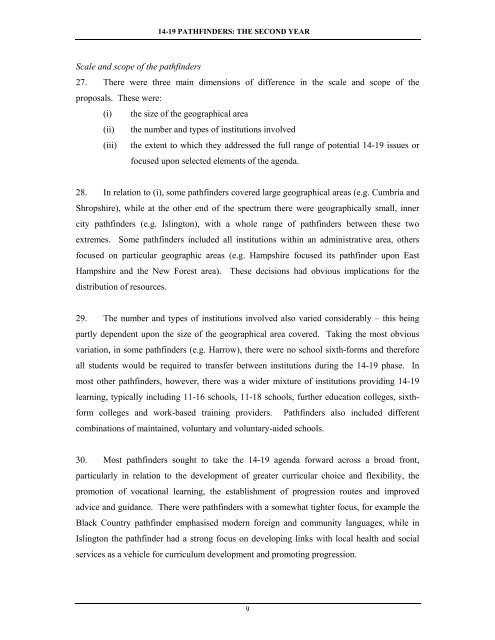Collaborative Approaches to 14-19 Provision - Communities and ...
Collaborative Approaches to 14-19 Provision - Communities and ...
Collaborative Approaches to 14-19 Provision - Communities and ...
- No tags were found...
Create successful ePaper yourself
Turn your PDF publications into a flip-book with our unique Google optimized e-Paper software.
<strong>14</strong>-<strong>19</strong> PATHFINDERS: THE SECOND YEARScale <strong>and</strong> scope of the pathfinders27. There were three main dimensions of difference in the scale <strong>and</strong> scope of theproposals. These were:(i) the size of the geographical area(ii) the number <strong>and</strong> types of institutions involved(iii) the extent <strong>to</strong> which they addressed the full range of potential <strong>14</strong>-<strong>19</strong> issues orfocused upon selected elements of the agenda.28. In relation <strong>to</strong> (i), some pathfinders covered large geographical areas (e.g. Cumbria <strong>and</strong>Shropshire), while at the other end of the spectrum there were geographically small, innercity pathfinders (e.g. Isling<strong>to</strong>n), with a whole range of pathfinders between these twoextremes. Some pathfinders included all institutions within an administrative area, othersfocused on particular geographic areas (e.g. Hampshire focused its pathfinder upon EastHampshire <strong>and</strong> the New Forest area). These decisions had obvious implications for thedistribution of resources.29. The number <strong>and</strong> types of institutions involved also varied considerably – this beingpartly dependent upon the size of the geographical area covered. Taking the most obviousvariation, in some pathfinders (e.g. Harrow), there were no school sixth-forms <strong>and</strong> thereforeall students would be required <strong>to</strong> transfer between institutions during the <strong>14</strong>-<strong>19</strong> phase. Inmost other pathfinders, however, there was a wider mixture of institutions providing <strong>14</strong>-<strong>19</strong>learning, typically including 11-16 schools, 11-18 schools, further education colleges, sixthformcolleges <strong>and</strong> work-based training providers. Pathfinders also included differentcombinations of maintained, voluntary <strong>and</strong> voluntary-aided schools.30. Most pathfinders sought <strong>to</strong> take the <strong>14</strong>-<strong>19</strong> agenda forward across a broad front,particularly in relation <strong>to</strong> the development of greater curricular choice <strong>and</strong> flexibility, thepromotion of vocational learning, the establishment of progression routes <strong>and</strong> improvedadvice <strong>and</strong> guidance. There were pathfinders with a somewhat tighter focus, for example theBlack Country pathfinder emphasised modern foreign <strong>and</strong> community languages, while inIsling<strong>to</strong>n the pathfinder had a strong focus on developing links with local health <strong>and</strong> socialservices as a vehicle for curriculum development <strong>and</strong> promoting progression.9
















